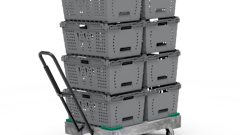
When is the right time to switch from in-house to outsourced fulfillment? Is it when storage spaces are bursting at the seams, or when the first wave of customer grievances hits?
Or perhaps, when the intricacies of operations start overshadowing the main business tasks?
A whopping 79% of e-commerce enterprises now rely on third-party logistics providers for fulfillment in at least one of their channels. This highlights the trust in external expertise as well as the evolving nature of modern business operations.
Let's decode the telltale signs that suggest a pivot toward outsourcing.
Indicator 1: Rapid business growth
Although rapid growth shows a booming business and more customers, it can also stretch internal resources thin — leading to mistakes and inefficiencies. E-commerce businesses shipping in bulk, especially those with heavy items, feel these challenges even more.
Imagine a local cheese maker getting a huge order from a national grocery store. It's a big win, but fulfilling it with just their team can be overwhelming. Or think of a gourmet pie seller seeing orders skyrocket before Thanksgiving. With the help of an external provider, they can tap into a bigger team and facilities, ensuring on-time and correct deliveries.
Advice: Businesses might want to try a hybrid approach: manage regular tasks internally but outsource during high-demand periods. This way, they can handle spikes without big investments. Also, using forecasting tools can help — businesses can plan ahead, either by boosting their internal operations or alerting their external partners.
Indicator 2: Increasing operational complexity
As businesses grow, they often diversify their offerings or explore new markets. For example, a company selling dry pantry items online might add fresh produce and dairy. This means they'll need cold storage, different stock rotation, and stricter food safety measures.
Going global adds even more layers. Shipping food internationally requires mastering global food rules and longer delivery times. A fulfillment partner with global know-how can help tackle these hurdles, ensuring products reach overseas customers in top shape.
Advice: Before branching out, businesses should run small tests. Introducing a few fresh items can help understand logistical issues and gauge customer interest. When entering foreign markets, teaming up with local experts can be invaluable. They can offer insights into local preferences and regulations, making the transition smoother.
Indicator 3: Inability to meet evolving customer expectations
Customers in this Amazon-dominated world want more: quicker deliveries, fresher items, and premium packaging. Today next-day delivery is often the norm and that leads to businesses facing unique hurdles. Imagine a customer in a landlocked area ordering fresh lobsters from a coastal shop. Delivering quickly without losing freshness is tough. A partner with specialized cold logistics can ensure prompt delivery while keeping the quality intact.
Advice: Set up a strong feedback system. By pinpointing customer issues, businesses can adjust their operations. If quick deliveries are a common request, think about establishing fulfillment hubs near key customer areas. This cuts down travel time and ensures fresher products.
Indicator 4: Cost inefficiencies
During busy times, labor and storage expenses can skyrocket. Picture a chocolatier gearing up for Valentine's Day — the demand spike might mean renting cold storage or hiring temporary staff, both pricey options.
Managing inventory efficiently is vital. For those selling perishables, unsold items often go to waste. An external provider might handle inventory better, ensuring items sell before expiring, cutting down on both waste and costs.
Advice: Adopt just-in-time (JIT) inventory methods. Stocking based on demand can lower storage fees and reduce waste. Also, think about dynamic pricing during high-demand periods — it can help clear stock quicker, ensuring quality and lowering storage fees.
Indicator 5: Lack of expertise or technology
The food logistics sector is always changing, with new tech constantly popping up. For example, Internet of Things (IoT)-enabled temperature sensors can track food items in real time during shipping. A frozen dessert seller without this tech or know-how might end up delivering melted treats. Partnering with a tech-savvy provider ensures products arrive as intended.
Also, blockchain in the food supply chain offers better tracking. A knowledgeable external provider can offer this, leading to faster recalls and more trust from consumers.
Advice: Companies should prioritize ongoing training for their staff. Keeping up with tech trends helps decide whether to upgrade internally or outsource. Joining industry groups can also be beneficial: they're great for learning, networking, and staying on top of industry shifts.
Making the move
Identifying the moment to pivot from in-house to outsourced order fulfillment isn't just about logistics — it's a strategic move to ensure a business's longevity and prosperity. When staying alert to these signs, businesses can transition seamlessly. That leads to cutting costs, boosting efficiency and elevating customer experiences.
Are your in-house operations truly aligned with your business's aspirations? Or might there be a goldmine of opportunities in outsourcing waiting to be unearthed? The key is to deeply understand your business dynamics and have the vision to adapt and thrive.





















